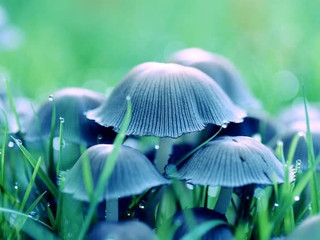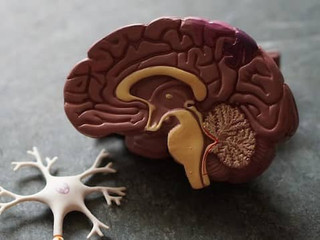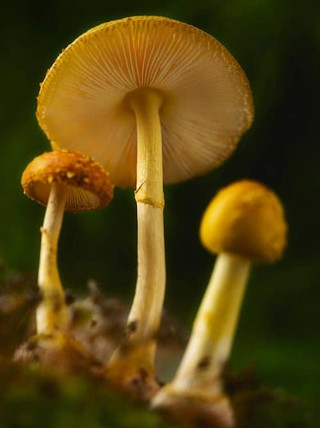Fungi Appear To Talk: A Mushroom Language Similar to Humans?
Posted by Troy Cosky, Founder FunGuy Grow Supply on 31st Jul 2023

Fungi Appear to Talk in Language Like Humans
Picture yourself strolling through a majestic forest, and beneath your every step, a vibrant network of fungi is engaged in a lively conversation. Mind-blowing, isn't it?
As you venture deeper into the mesmerizing world of fungi, you'll uncover their very own 'language,' where electrical impulses dance in response to stimuli. Each species possesses a unique lexicon, a wondrous array of electrical patterns akin to words.
Deciphering these intricate 'words' isn't a walk in the park; it's a profound challenge that researchers are tackling. The potential rewards are astonishing, opening doors to groundbreaking fields like biocomputing and ecological design.
Sure, some folks remain skeptical, but the boundless possibilities are far too captivating to dismiss. Join me on this journey of exploration into the enigmatic realm of fungal communication - a treasure trove awaiting our understanding.
Key Takeaways
- Fungi have their own unique language and means of communication, which involves changes in electrical potential.
- Each species of fungi has its own lexicon or set of words in their language.
- Fungi do not have nervous systems, but they use their mycelium networks to distribute carbon and communicate with other organisms.
- Professor Andrew Adamatzky's research has focused on studying the electric pulses and patterns of spikes in different mushroom species, identifying unique words spoken by each species.
Fungal Communication Mechanisms
Fungi, despite not having a nervous system like ours, use their mycelium networks to communicate and distribute carbon between organisms. This is one of the key fungal communication mechanisms. Each species of fungi has its own unique lexicon, a language of sorts that scientists are only just beginning to decipher.

Now, you might be wondering: how do mushrooms communicate? Well, it's not through any auditory or visually recognizable means, but through subtle changes in their mycelium networks. These intricate, branching networks serve as the mushroom communication network, facilitating the transfer of information and materials across vast distances. It's through this network that mushrooms communicate with each other, sending signals that are thought to resemble words in a language.
What's even more astonishing is the recent discovery that fungi talk like humans. Fungi use something akin to our language, employing electrical signals to communicate. The evidence strongly suggests that fungi do communicate, and in far more complex ways than we ever imagined. Every mushroom electric signal, every spike in potential, is a word in the fungal language.
However, the task of deciphering this language is still in its infancy. We're just beginning to understand the nuances of mycelium communication, the symphony of signals that constitute the conversations of fungi. But with every discovery, we inch closer to understanding the language of mushrooms, opening up new possibilities for our relationship with these amazing organisms.
As we venture deeper into this fascinating world, we'll continue to explore the remarkable phenomenon of mushroom electrical signals.
Mushroom Electrical Signals
Imagine deciphering an intricate code, not from a secret spy organization, but from a network of mushrooms, communicating through electric signals! This isn't a scene from a science fiction movie, but a study conducted at the University of the West of England.

Researchers there discovered a fascinating aspect of mushroom intelligence - fungi communication via electrical impulses.
- Scientists inserted electrodes into four species of fungi.
- They observed and analyzed these mushroom electric signals.
- The impulses formed clusters that resemble words.
- This electrical sequence potentially constitutes a fungi-specific vocabulary.
This research highlights that mushrooms aren't solitary organisms. Rather, their communication not only reflects a degree of fungi intelligence but also suggests a level of complexity and social interaction among them. These electric mushrooms, through their electrical signals, likely convey information crucial for their survival and well-being. This could include food location, injury signals, or environmental changes. The study's findings challenge our understanding of non-animal communication, offering a fresh perspective on how mushrooms communicate.
Don't mistake this for a simple random electrical activity. These mushroom electrical signals form intricate clusters that resemble words, suggesting a structured form of communication. Furthermore, each species of fungi appears to have its own lexicon, almost like different dialects in human languages. This discovery adds a new dimension to the study of mushroom communication and mycology.
As we delve deeper into this fascinating world of fungal communication, we come closer to translating this unique linguistic system. So, the next question that naturally arises is, how do we decode this fungal language? It's time to explore this enigmatic communication further.
Decoding Fungal Language
Unraveling the cryptic dialogue of mushrooms might seem like an uphill task, but it's not entirely out of reach, as we are on the cusp of a scientific breakthrough. The possibility of a 'fungi language humans' could decipher is becoming more plausible. Scientists like Andrew Adamatzky have been decoding fungal language, translating the electrical signals emitted by fungi into a lexicon of words. This process is revealing a mushroom vocabulary that points to a form of fungal intelligence.

Fungi communicate through changes in electrical potential, with each species exhibiting unique patterns of language characteristics. This fungus communication is more complex than previously thought. For instance, enoki fungi showcase diverse electrical activity patterns, while the split gill fungus is one of the fastest-spiking species. This research has begun to answer the question, 'Are fungi intelligent?', and it indicates that mushrooms communicate with each other using electrical impulses.
| Fungi Species | Language Characteristics |
|---|---|
| Enoki | Diverse patterns of electrical activity |
| Split Gill Fungus | High amplitude spikes, fast-spiking |
| Cordyceps Militaris | Average of 8.9 spikes per word |
| Omphalotus Nidiformis | Average of 3.3 spikes per word |
Understanding this 'mushroom language' could help us monitor environmental changes, as fungi are sensitive to changes in soil quality, water purity, and pollution levels. Thus, can fungi communicate? The evidence points to a resounding yes. As we further explore this fascinating field, our comprehension of fungi communication networks could lead us to a greater appreciation of the complexity and intelligence of these organisms. This takes us to the next intriguing question - the existence of fungal consciousness, which we will explore in the following section.
Existence of Fungal Consciousness
Isn't it fascinating to ponder the possibility of consciousness existing in organisms beyond our own species? Consider this: fungi, with their complex mycelial networks, exhibit traits akin to intelligence. They respond to stimuli, exhibit selfhood, and form intricate networks in the soil that interconnect with plants and other fungi. These networks facilitate nutrient transport and exchange of information, suggesting a form of 'fungus intelligence' that challenges traditional notions of consciousness.

The existence of fungal consciousness isn't as far-fetched as it may seem. Fungal mycelia are sensitive, indicating consciousness comparable to that of multicellular organisms. An injured fungal colony reacts, suggesting self-awareness. Even though this consciousness might not mirror human self-awareness, it is an enriching phenomenon produced by cellular processes across all species. Consciousness, it appears, isn't exclusive to humans.
But here's the real kicker: not only do fungi exhibit consciousness, but they also communicate in a language somewhat similar to humans. Amazing, isn't it? Some researchers claim that mushrooms communicate with each other, each species speaking its own lexicon. This 'mycelial intelligence' is still not fully understood, but it opens a whole new dimension in fungal research.
This understanding of the fungi world heightens our respect for these organisms and expands our perception of consciousness. It also begs the question: If fungi are conscious and can communicate, what potential applications could this have? Imagine the possibilities if we could harness this intelligent fungi communication in the field of biocomputing. Let's dive into this exciting possibility next.
Mushroom Applications in Biocomputing
You might be wondering, what's the connection between mushrooms and cutting-edge technology like biocomputing? Well, let's delve into this fascinating topic.

The study of mushrooms, called mycology, has uncovered some astounding traits of these organisms, leading scientists like Andrew Adamatzky to explore their potential in unconventional fields like biocomputing.
Researchers have discovered that mushrooms communicate through complex networks underground, triggering a whole new perspective on mushrooms' intelligence. These intricate networks, called mycelium, not only facilitate the exchange of nutrients but also transmit electrical signals. This characteristic has led to the concept of a 'fungal computer,' where these electrical signals are harnessed for computational purposes.
Adamatzky's study on mushroom applications in biocomputing has shown that the electrical activity in mushrooms can be translated into a form of language, albeit a slow one. Despite not having a nervous system, mushrooms generate electrical spikes in their mycelium, a phenomenon Adamatzky has leveraged to interpret and utilize these signals for computing measures.
However, the application of mushroom science in biocomputing is not without its challenges. The signals are faint and complex, requiring a uniquely developed algorithm to detect and interpret them. Furthermore, compared to silicon chips, fungal computers are slower. But the potential benefits – resilience, self-maintenance, and rapid growth – make them a promising area for exploration.
As we venture further into this realm of 'talking mushrooms,' we stand at the precipice of a revolution in how we perceive and utilize biological materials. This understanding of fungal communication could not only revolutionize technology but also provide profound insights into the ecological significance of fungi, a subject we will explore in the next section.
Fungal Ecological Significance
Peering beneath the surface of our world, it's astounding to realize that a vast network of communication and interaction is happening right under our feet, courtesy of mushrooms and their mycelial networks. It's not just a simple chat, but a complex language, with each mushroom species having its own lexicon. The intricate networks of mycelium, the root structure of fungi, act as nature's internet, facilitating communication between organisms and distributing carbon.

The ecological significance of fungi is immense. Fungi are crucial players in nutrient cycling, with their mycelial networks acting as conduits for material exchange. They also play a role in soil health and carbon sequestration, which are vital for tackling global climate change.
- Fungi Communication: Fungi talking to each other is an intriguing concept. Evidence suggests mushrooms communicate words through changes in electrical potential.
- Are mushrooms intelligent?: The existence of a complex communication system might hint at a level of intelligence, although this remains a topic of debate.
- Do mushrooms talk to each other?: the complex language of fungi suggests that they do.
- Ecological Significance: Fungi are not only significant for their communication but also for their role in the environment. They transform nutrients for plant availability and contribute to soil carbon stock.
- Human Relevance: The mushroom-human connection is more profound than we realize. Understanding their language could lead to advancements in various fields, including biocomputing.
As fascinating as the world of mushroom language is, the journey to understanding it isn't without its challenges. Decoding the messages and meanings behind each spike and pulse is a task that requires patience and perseverance. Let's thoroughly explore these challenges in the next section.
Challenges in Studying Fungal Language
Navigating the world of mushroom chatter is like trying to solve a complex puzzle – full of intrigue, yet riddled with challenges. As a mycologist, a person who studies mushrooms, you're constantly faced with the question, 'Do mushrooms talk to each other?' The study of mushrooms, called mycology, has long been fascinated with the intricate network of mycelia - a web that seems to be an intricate communication system.

Fungi appear to talk, not in the conventional sense, but through intricate networks of mycelium. These signals, translated into what we now call the 'fungal language', are complex and not easily understood. Mushrooms communicate claims with each other using these signals, making the mycelial network a veritable underground internet.
However, the challenges in studying fungal language are substantial. First, fungi do not have a nervous system like ours, making their communication vastly different from anything humans are familiar with. Additionally, the language of fungi is slow, often taking hours or even days to transmit a single message through the mycelium network. Decoding this slow and complex language requires an immense amount of patience and a deep understanding of fungal biology.
The skepticism among some scientists about whether these signals constitute a translatable language also poses a challenge. The complexity of the fungal language, its slow communication processes, and the need for interdisciplinary approaches to fully understand it can be daunting. Yet, the potential rewards are great – from understanding ecological processes to potentially unlocking new avenues in biocomputing.
As we continue to grapple with these challenges, our focus must shift towards the future – exploring new techniques, fostering collaborations, and pushing the boundaries of what we understand about the fascinating world of fungi.
Future Directions in Mushroom Linguistic Research
Let's envision what the future might hold in the quest to unravel the mysteries of these complex networks. Future directions in mushroom linguistic research, particularly in the realm of 'fungi language humans', are geared towards the possibility of not just understanding, but potentially communicating with fungi.

The scientific word for mushroom, 'mycetozoa', might soon be followed by a lexicon of mushroom language that humans can comprehend. Can mushrooms talk? Current research suggests that they indeed communicate through intricate mycelial networks. The question now is to decipher what these mushrooms are saying. Are mushrooms sentient? This remains a contentious topic. While they don't possess a brain or a nervous system like animals, their complex communication networks and response to stimuli suggest a form of intelligence.
The phrase 'mushrooms can talk' may seem fanciful, but it's grounded in rigorous scientific research. Fungi, through their mycelial networks, exchange nutrients, send warning signals, and more. It's essentially mushrooms talking to each other and other organisms in their environment.
The future of this field is filled with potential. Imagine being able to 'talk' to a mushroom, understanding its needs, and responding appropriately. Could this pave the way for more sustainable agricultural practices, improved ecosystem management, or novel biotechnological applications?
While we are still in the early stages of understanding this 'mushroom talking', the journey ahead is promising. We will continue to delve into the complexities of these networks, striving to decode the enigmatic language of fungi.
As we transition to the next section, we will explore the wonders of mycelial networks and their role in this fascinating form of communication.
Mycelium Networks and Communication
We're delving into the intricacies of mycelial networks and their vast communication systems, a complex web of interactions that are reshaping our understanding of these organisms and their place in the world. It's a world where mushrooms talk, whispering secrets in a language we're just beginning to decode.

Let's take a closer look at this so-called 'fungi language humans' are trying to decipher. Fungi communicate through changes in electrical potential, a process facilitated by their mycelial networks. Each species has its own mushroom vocabulary words and its unique lexicon. While they don't possess a nervous system like ours, they do have mycelial networks that act much like our brains, transmitting information through electrical impulses and electrolytes.
| Fungi Language Humans | Definition |
|---|---|
| Mycelium Networks and Communication | Fungi's system of interacting and transmitting information |
| Mushroom Vocabulary Words | Unique lexicon used by each species |
| Talking Mushrooms | Concept of fungi communicating through electrical changes |
| Mushroom Words | Signals or 'words' used in fungi communication |
Despite the invisibility of individual hyphae, this network of mycelium can extend for hundreds or even thousands of miles. Imagine a group of mushrooms called a 'mycelial network', sharing resources, relaying information, and making decisions. It's a system that ensures neighboring plants have the necessary resources and contributes to leaving the earth better than they found it.
We're just beginning to grasp this complex language system, where mushrooms talk and each species has its own words for mushrooms. As we continue to unravel the mysteries of human mushroom communication, bear in mind that our understanding is still in its infancy. This brings us to the skepticism from scientists about the existence and functionality of fungi language, a topic we'll explore next.
Skepticism from Scientists
Despite all the excitement, it's important to remember that not every scientist is ready to embrace the notion of chatty mushrooms just yet. As intriguing as the idea of a ' blind language' among fungi is, there remains a substantial amount of skepticism in the scientific community. Some question whether the electrical signals observed in mushrooms, such as the ghost shrooms and huautla mushrooms, truly represent a form of communication or are just random noise.

The ghost shrooms, known scientifically as Omphalotus nidiformis, and huautla mushrooms, a species of psilocybin honey mushrooms, are among the many fungi that have exhibited electrical activity. Yet, these electric spikes don't necessarily translate into language as we understand it. Even if we consider the electrical signals as words, there's still the matter of deciphering what these words mean. What do mushrooms symbolize with each spike in their electrical activity? Do the blue honey mushrooms' signals mean something different from those of the psychedelic honey mushroom? Until we can answer these questions, the talk of a mushroom language remains speculative.
As fascinating as the idea of fungi communicating via electrical impulses is, it's important not to rush to conclusions. It's equally plausible that these electrical signals are part of a complex physiological response to environmental changes, rather than a form of communication. Images of fungi, or 'pic of fungi' as it's colloquially known, often depict them in isolation, but they are deeply integrated into their ecosystems, responding to a myriad of factors. The truth about the language of blue honey psilocybin and other mushrooms may yet elude us, but the quest for answers continues.
Conclusion: The Electrical Language of Fungi
The mind-boggling abilities of mycelium networks to communicate through electrical signals will forever change our understanding of the natural world. It is truly remarkable to think that mushrooms, often seen as mere organisms in the forest, possess a complex language that allows them to interact and share information with one another.

When a group of mushrooms, known as a mycelium network, encounters a threat or a resource, they can talk to each other using electrical signals. This communication occurs through a complex system of interconnected hyphae, which are thread-like structures that make up the body of the fungus. By sending electrical signals, mushrooms can warn each other of dangers, share nutrients, and even coordinate their growth.
One fascinating example of this electrical language is the blue honey mushroom, also known as the electric mushroom. This particular species has been found to emit electrical pulses that can travel through the mycelium network, allowing it to communicate over long distances. These electrical signals are believed to play a role in the mushroom's ability to find and colonize new resources.
In conclusion, the study of fungi has revealed a whole new world of communication and interaction. Mushrooms communicate with each other using an intricate electrical language, allowing them to thrive in their environments. This discovery opens up new avenues for research and understanding of the natural world, showing us that the fungal kingdom is far more complex and intelligent than we could have ever imagined.
Ready to Cultivate Your Own Fungi Language? Visit FunGuy Mushroom Supply Now!
Unlock the Secrets of Fungi Language and Start Your Mushroom Journey Today! Visit FunGuy Mushroom Supply for Top-Quality Grow Kits, Spawn Bags, and More!
Frequently Asked Questions

What are some specific examples of how fungi communication has been observed in nature?
In nature, fungi communication can be observed through mycelium networks. These networks, often called the 'wood wide web', enable fungi to interact with plants and assist in their nutrient uptake.
Research has demonstrated that fungi can modify their electrical signaling in response to different stimuli, similar to how neurons operate in a brain. Fascinatingly, various fungal species display distinct electrical signaling patterns, suggesting the presence of a unique 'language' for each species.
How does the electrical activity in fungi compare to that in the human nervous system?
Just like your nervous system, fungi use electrical signals for communication. Instead of neurons, they use their mycelial networks, akin to our neural networks.
These electrical impulses in fungi, much like our nerve impulses, change in response to stimuli such as light and touch. However, the complexity of fungal electrical signaling is yet to be fully understood and it's still unclear how closely it mirrors human neuronal activity.
What is the important significance of fungal language and communication in ecological processes and its potential applications in biocomputing?
The significant importance of fungal language and communication in ecological processes and its potential applications in biocomputing should not be underestimated. Fungi play a critical role in ecosystems, interacting with other organisms, including trees and insects, while contributing significantly to nutrient cycling and decomposition. By comprehending fungal language, which encompasses changes in electrical potential and mycelium networks, we gain valuable insights into how fungi communicate and distribute essential resources necessary for their growth and survival.
In the realm of biocomputing, the research on fungal electrical signals, as conducted by Professor Andrew Adamatzky and his team, unlocks new opportunities. These electrical signals exhibit similarities to human nerve impulses and showcase distinct patterns across various mushroom species, forming lexicons of up to 50 words for each species. This indicates that fungal language, though not entirely deciphered, holds the potential to be practically applied in developing innovative essay writing service, and more importantly, computing systems that replace conventional components with biological elements.
How close are researchers to fully deciphering the fungal language?
Researchers are still in the early stages of deciphering fungal language. They've observed electrical signals and identified a lexicon for each species, but the meaning of fungal words remains elusive. This is a complex, slow process that requires further exploration.
Even though we've made promising strides, fully understanding and translating this language is a goal that's yet to be reached. Keep in mind that interdisciplinary collaboration is crucial in this ongoing research endeavor.
What are some philosophical implications of the existence of fungal consciousness?
The notion of fungal consciousness challenges our traditional understanding of intelligence and cognition. It compels us to consider intelligence as a non-exclusive property of complex brains, suggesting a form of awareness in seemingly simple organisms.
This raises questions about the nature of consciousness and pushes us to rethink how we perceive and interact with non-human organisms. It forces us to question the boundaries we have set between humans and other species, blurring the lines between what is considered "intelligent" and what is not.
Additionally, the existence of fungal consciousness brings up ethical considerations. If fungi are indeed conscious beings, how should we treat them? Should we continue to exploit them for our own purposes, or should we afford them the same moral consideration we give to other sentient beings?
These philosophical implications challenge our preconceived notions about intelligence, consciousness, and our relationship with the natural world. They invite us to broaden our perspectives and engage in deeper reflections on the interconnectedness of all living beings.
Can the principles of mushroom applications in biocomputing be applied to other biological systems?
Absolutely, the principles of mushroom applications in biocomputing can be applied to other biological systems.
It's about harnessing nature's inherent processes for computational tasks. Just as mushrooms communicate through electrical signals, other organisms may exhibit similar capabilities.
This could lead to biological systems becoming platforms for bio-computational processes, with potential applications in environmental monitoring, healthcare, and more.
However, the translation of these bio-communications into usable data presents a significant challenge and requires further research.
References
- Adamatzky A. (2022). Language of fungi derived from their electrical spiking activity. Royal Society open science, 9(4), 211926. https://doi.org/10.1098/rsos.211926
- Leeder, A. C., Palma-Guerrero, J., & Glass, N. L. (2011). The social network: deciphering fungal language. Nature reviews. Microbiology, 9(6), 440–451. https://doi.org/10.1038/nrmicro2580
- Adamatzky A. (2018). Towards fungal computer. Interface focus, 8(6), 20180029. https://doi.org/10.1098/rsfs.2018.0029
- Money N. P. (2021). Hyphal and mycelial consciousness: the concept of the fungal mind. Fungal biology, 125(4), 257–259. https://doi.org/10.1016/j.funbio.2021.02.001
- Meyer, V., Andersen, M. R., Brakhage, A. A., et al. (2016). Current challenges of research on filamentous fungi in relation to human welfare and a sustainable bio-economy: a white paper. Fungal Biol Biotechnol, 3, 6. https://doi.org/10.1186/s40694-016-0024-8
- Hernandez, H., & Martinez, L. R. (2018). Relationship of environmental disturbances and the infectious potential of fungi. Microbiology (Reading, England), 164(3), 233–241. https://doi.org/10.1099/mic.0.000620
- Money N. P. (2022). New theories expand cognition to fungi. Research Outreach, 128. Available at: https://researchoutreach.org/articles/new-theories-expand-cognition-to-fungi/
- Padder, S. A., Prasad, R., & Shah, A. H. (2018). Quorum sensing: A less known mode of communication among fungi. Microbiological research, 210, 51–58. https://doi.org/10.1016/j.micres.2018.03.007

